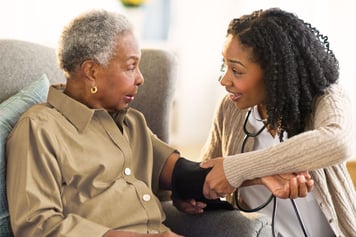Urinary tract infections (UTIs) remain a significant driver of care complications and hospital admissions each year in the United States, especially for older adults.
As the second most common type of infection, UTIs are very common in the U.S. In fact, about 10 in 25 women and 3 in 25 men will experience UTI symptoms during their lifetime. In older adults, UTIs are the third leading cause for hospitalization for infection and impact many home health care patients each year.
Further complicating the picture for this patient population is the fact that symptoms of a urinary tract infection in older populations often present atypically, especially in those with Alzheimer’s and other forms of dementia. To avoid costly hospital stays, it’s important to follow current evidence-based practices to identify and manage UTIs in elderly populations.
Common UTI Symptoms
Common risk factors for UTI in older adults include previous history of UTI, multiple comorbidities, exposure to infectious pathogens (more common in long-term care facilities), reduced immunity (common with aging) and urinary catheter use. Of identified infections, Escherichia coli (E. coli) is the most common cause.
[action 1]
Monitoring for the following signs of UTI in older adults can support proactive diagnosis:
Classic UTI Symptoms
Because UTIs affect different parts of the urinary system, symptoms might present differently:
- Infection in the kidneys can come with back or side pain
- Infection in the bladder can come with pelvic pressure, lower belly discomfort and frequent, painful urination
- Infection in the urethra can come with burning during urination and possible discharge
- In cases of severe infection, fever and chills, nausea, vomiting, and abnormal urine odor can be late symptoms.
For some older adults, these classic symptoms might be harder to recognize because of a suppressed immune response.
UTI Symptoms Specific to Older Adults
For older adults, symptoms might also include:
- Mental status changes like confusion or unusual behavior
- Incontinence
- Agitation
- Lethargy
- Falling
- Urinary retention
- Decreased mobility
- Decreased appetite
How to Avoid UTIs in Elderly Populations
Late signs of UTI are cause for alarm, with 25% of sepsis cases attributable to UTIs. Some tips for helping prevent UTIs in vulnerable populations include:
1. Understand common risks in older adults.
A person’s health history can reveal a lot about their likelihood of experiencing a UTI. For example, diabetes can impact the immune system’s response to defense against germs. Bladder incontinence—common in older populations—can also increase the risk of a UTI.
2. Encourage adequate fluid intake.
Research supports increasing hydration (if not on a fluid restricted diet) as a strategy for reducing risk of UTI. Staying hydrated can also help improve immune response.
3. Avoid urinary tract irritants.
Coffee, alcohol, highly acidic foods and carbonated soft drinks are common urinary tract irritants that should be avoided during a UTI. However, if someone is prone to UTIs, it’s best practice to avoid these irritants in general.
4. Encourage proper hygiene.
In addition to taking daily showers, regularly changing underwear and washing clothes consistently, those who require incontinence briefs should change several times a day.
5. Avoid urinary catheters.
Catheter-acquired urinary tract infections (CAUTIs) are a significant source of infection and related healthcare costs each year in the United States. Initiatives to reduce the use of catheters have shown large reductions in the rate of infection.
Reducing Avoidable Hospitalization
If a UTI does occur, partnering with a home health provider that prioritizes a strong evidence-based UTI protocol can help ensure patients avoid hospitalization. At Amedisys, our UTI protocol includes advanced molecular testing for rapid identification of urinary pathogens with more accurate results and targeted treatment recommendations. In addition to proactive management of UTI symptoms, our nurses provide education on proper hygiene, symptoms of UTI to watch for and measures to prevent UTIs. This includes support for coexisting conditions that increase the risk of UTI, with resources like our home health diabetes care program to help patients lead healthier lives.
To help prevent UTIs in your patients, we created a resource highlighting just what you need to know so that you can do your job more efficiently. Download and print out a copy of Reducing Avoidable Hospitalizations Due to UTIs.




